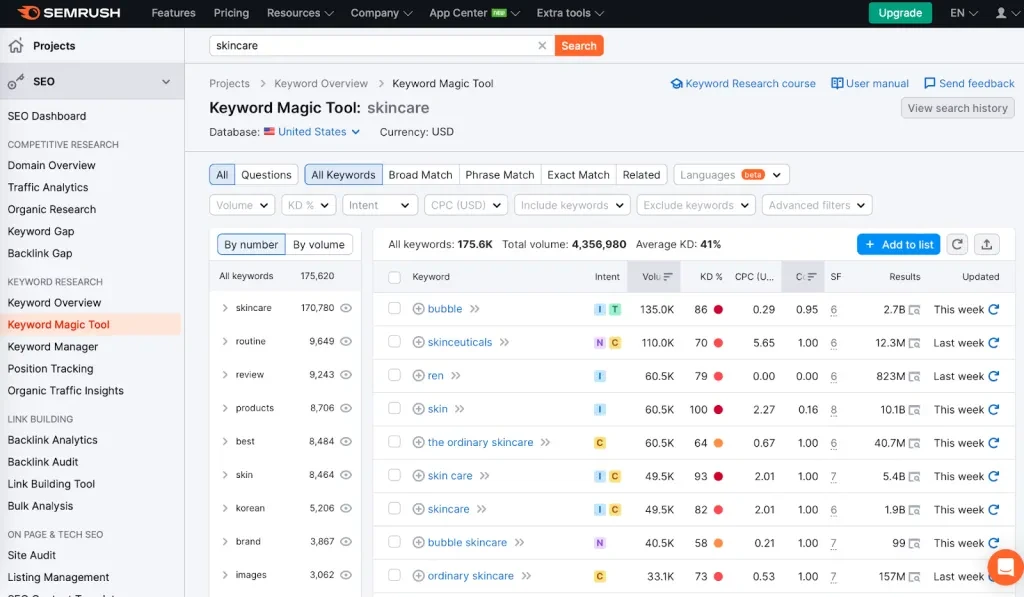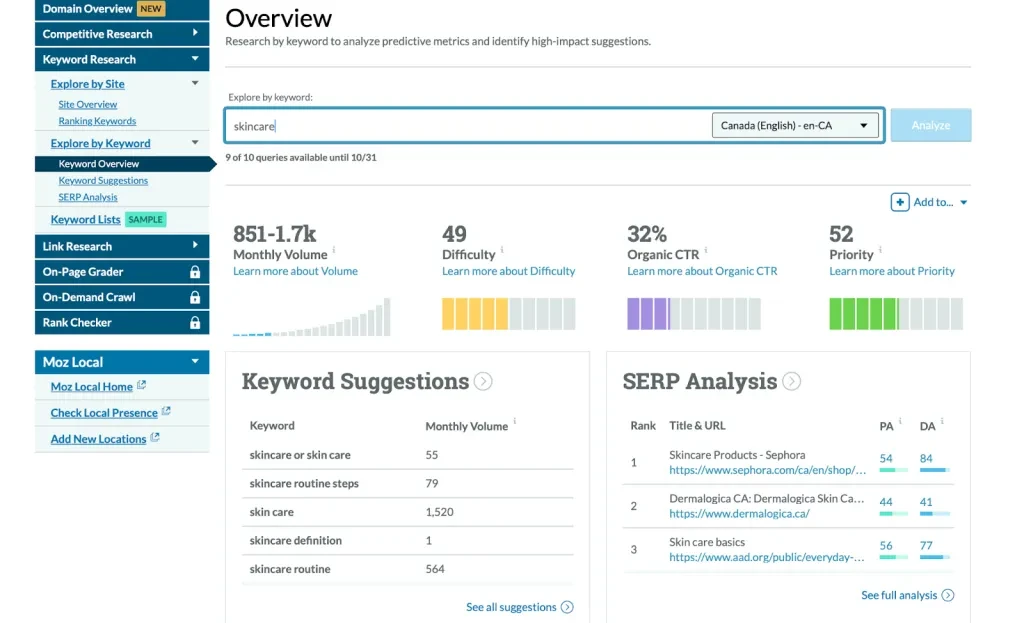If you’re here, you probably already know that a business blog is an effective marketing tool. However, figuring out where to start when determining what to write about can be tricky. Sure, you know your content niche and the big ideas your business should cover, but how does that translate to individual blogs? Or, what if you already have a blog but feel like you’ve already addressed all the important topics?
Here, we will talk about the different types of blog content you might want to consider writing and provide some tips on generating new blog ideas regardless of whether you’re new to blogging or have an established blog.
Table of Contents
Types of blog content
Generating blog ideas for a new business blog
Tips to generate new blog ideas for an established blog
Tools that can help with idea generation
Using AI to help with idea generation
The importance of updating content
Next steps
Types of blog content
Before creating a list of blog ideas, it’s important to understand the different types of content you can create to identify the best content for your business and your audience. Additionally, it’s essential to post a variety of content, so thinking about these categories can help with idea generation.
Types of blogs that your business may consider publishing:
- Educational blogs: These blogs provide valuable information, tips, and insights about the industry or products/services the business offers. They position the business as an authority and help educate the audience.
- How-to guides and tutorials: Step-by-step guides and tutorials help customers understand how to use a product or service effectively. They can also be used to teach related skills or provide DIY solutions.
- Industry news and trends: Blogs covering the latest news and trends in the industry demonstrate that the business is up-to-date and in touch with current developments.
- Product or service updates: These blogs inform customers about new product releases, updates, or improvements.
- Customer stories/testimonials: Sharing customer stories, testimonials, and reviews can build trust and credibility. Businesses can showcase real-world examples of their product/service solving problems.
- Lists and roundups: Compiling lists of resources, tools, or industry insights can be a great way to engage the audience. For example, “Top 10 Tools for Small Businesses” or “Best Marketing Strategies in 2023.”
- Thought leadership: Expressing the business’s unique viewpoint on industry issues or challenges can establish thought leadership and provoke discussions.
- Behind-the-Scenes: These blogs offer a peek into the inner workings of the business, including company culture, team members, or the manufacturing process, which humanizes the brand.
- FAQs and troubleshooting: Addressing common customer questions and providing solutions to common problems can enhance customer satisfaction and reduce support inquiries.
- Seasonal or holiday content: Tailor content to specific seasons or holidays. For example, “Summer Fashion Trends” or “Valentine’s Day Gift Ideas.”
You may also want to consider guest blogs. Inviting industry experts or influencers to write guest posts can bring fresh perspectives and expand the audience.
The choice of blog type should align with the business’s goals, target audience, and content strategy, and as we mentioned, mixing and matching different types of blogs can keep the content fresh and engaging.
Generating blog ideas for a new business blog

The next most important things when generating blog ideas for a brand new blog are 1) the target audience and 2) the keywords your business wants to target.
Know your audience
Understanding your target audience allows you to create content relevant to their needs, interests, and pain points. This is vital to capturing their attention and keeping them engaged. Additionally, when your blog content aligns with the needs and interests of your target audience, it can lead to higher conversion rates.
Whether your goal is to generate leads, make sales, or achieve other objectives, content that speaks to your audience is more likely to drive desired actions.
Brainstorming and keyword research
Keyword research provides insights into the content landscape in your niche. You can plan your content strategy by understanding the types of content that perform well for specific keywords and adapt your ideas accordingly. It also helps you discover the specific words and phrases that your target audience uses when searching for information related to your industry, products, or services. And these keywords can serve as the basis for generating blog topic ideas.
Additionally, grouping related keywords into clusters helps plan a series of blog posts. For example, if you’re in the health and wellness industry, a keyword cluster could include “nutrition,” “exercise,” “mental health,” and “weight loss,” each leading to various blog ideas within those topics.
Tips to generate new blog ideas for an established blog

If you have an established blog, generating new ideas can sometimes be challenging because it feels like you’ve written about all the important topics already.
One thing that’s critical when it comes to business blogging is staying organized with your content. It would help if you had a content log showing all the published content so you can see what you’ve written and find where the gaps are.
And that’s my first tip! Take a look at the content you already have and find the gaps. Can you go deeper into these topics? Are there more specific keywords you could aim to rank for? Are there any pieces that might be missing?
Here are some other strategies for generating content ideas (these can apply to both new and established blogs):
- Competitor analysis: Analyze what topics your competitors are covering successfully to help you identify content gaps and opportunities.
- Industry trends: Stay updated on industry news, trends, and developments and write about emerging trends and their impact on your audience. Some great places to look for industry trends include Statista, WGSN for Apparel, and the Nelson Consulting Group data reports.
- Customer feedback: Listen to customer feedback, comments, and questions. Address their concerns and create content that provides solutions. Use surveys to see what customers are looking for or what questions they have unanswered.
Tools that can help with idea generation
There are several online tools that can help with keyword research. With these tools, you enter the keyword or phrase you are hoping to rank for and they will provide a list of related keywords and phrases that can help spark blog topic ideas. These related keywords can also help ensure you cover a topic entirely.
The top keyword tools include: Google Keyword Planner, SEMrush, Ahrefs, and Moz Keyword Explorer.
Google keyword planner

- Purpose: Google Keyword Planner is a free tool provided by Google Ads. It is primarily used for planning and managing Google Ads campaigns but is also valuable for SEO keyword research.
- How it works: Users enter a list of keywords, and the tool provides data on search volume, competition, and suggested bid amounts for paid advertising. It also suggests related keywords and allows users to filter results by location and language.
SEMrush

- Purpose: SEMrush is an all-in-one marketing tool that offers keyword research, competitive analysis, and SEO optimization features.
- How it works: Users can enter a keyword, and SEMrush provides comprehensive data, including search volume, keyword difficulty, and the number of search results. It also offers keyword variations, related keywords, and competitor analysis. SEMrush tracks keyword rankings and provides recommendations to improve SEO.
Ahrefs

- Purpose: Ahrefs is a comprehensive SEO tool that includes a robust keyword research feature.
- How it works: Ahrefs offers keyword data such as search volume, keyword difficulty, and the number of clicks and impressions. It provides information on the top pages and websites ranking for a keyword, as well as keyword suggestions, related terms, and content ideas. Ahrefs also tracks backlinks and provides insights into competitor strategies.
Moz Keyword Explorer

- Purpose: Moz Keyword Explorer is part of Moz Pro, an SEO software suite. It focuses on simplifying keyword research and analysis. You can access the basic functionality of the keyword explorer with the free version.
- How it works: Users can enter a keyword, and Moz Keyword Explorer provides data on search volume, keyword difficulty, and organic click-through rates. It offers keyword suggestions, prioritizes keywords based on their potential value, and provides insights into SERP (Search Engine Results Page) features. Moz also tracks keyword rankings over time.
These tools work by aggregating data from various sources, including search engines, to provide insights into the competitiveness and potential of specific keywords. They help users identify keywords relevant to their content and likely to drive organic website traffic. Additionally, these tools offer insights into competitors’ strategies, which can inform content creation and SEO optimization efforts.
Using AI to help with idea generation
Many content managers and writers are now embracing AI for idea generation support. AI-driven tools designed for generating content ideas, such as HubSpot’s Blog Ideas Generator and Portent’s Content Idea Generator, offer diverse topic recommendations rooted in your provided input.
These sophisticated tools employ natural language processing algorithms to evaluate existing content and generate fresh ideas. While not every suggestion may align perfectly with your needs, they serve as inspiration to ignite creativity for your blog.
The importance of updating content
While it’s important to steadily create new content, updating existing blog content is critical to ensure it stays relevant. Updating content signals to your audience that you are a reliable source of information. Additionally, it improves SEO, which can recapture some of the lost traffic.
Outside of ensuring the content is still relevant and has the most up-to-date information, pay attention to the blog formatting, check for broken links, and improve keywords if applicable.
How often should you update blog content?
There isn’t an exact timeline on how often you should be updating blog content but there are a few things to consider. First, some content may require more regular updating than others, for example, content that is based on data or research is likely to need more regular updating. Also, you may want to look specifically at updating content that is under performing to see if there are improvements that can be made to increase traffic.
Neil Patel suggests reviewing and updating content at least once a year, but remember, it’s important to balance creating new content with updating older content.

Next steps
Now that you know where to start, it’s time to brainstorm and write a list of content ideas for your blog. Remember to consider all the content categories and stay organized with your ideas.
Once you have a list of ideas, the next step is building a content calendar.
A content calendar is a physical plan for how often you will publish new blogs and which blogs you will publish and when so you can stay on track with content. Not sure how to make a content calendar? Learn more here.



